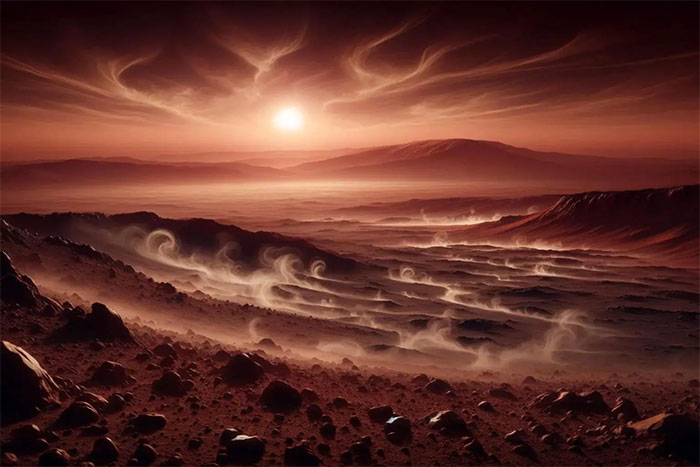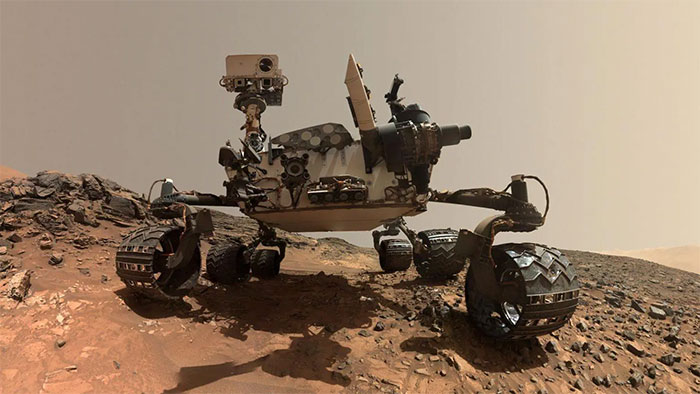NASA robots continuously catch 'unexpected life signals'
Methane, one of the signs that suggests alien life, was found in an absurd way by the Curiosity robot.
Research just published in the Journal of Geophysical Research: Planets has found an explanation for a mobile chemical laboratory on NASA's Curiosity robot continuously detecting traces of "life gas" methane. (CH 4 ) from the surface of Gale Crater on Mars.

The Gale Crater landscape that the Curiosity robot is surveying - (Graphic photo: SCITECH DAILY).
Curiosity, shaped like the famous cartoon character Wall-E, is NASA's robotic rover lander, operating on Mars since August 2012 with the mission of hunting for life.
This lucky robot is the first warrior to discover the existence of "building blocks of life" on the red planet.
However, evidence from then until now shows that Mars appears to be extinct and NASA mostly only expects to collect evidence of ancient life.
So when the mobile SAM lab in Curiosity's belly analyzed samples from Gale Crater - an ancient impact crater - and repeatedly found evidence of escaping methane, the scientific community was confused.

Curiostity Robot - (Photo: NASA).
Living organisms produce the majority of methane on Earth. Therefore, methane has long been considered a sign of potential life that astrobiologists are still trying to trace in the spectra of other planets.
But in Gale Crater or anywhere else on Mars, no device has detected a single living creature. Therefore, NASA absolutely did not expect methane to appear here.
"It's a story with many unexpected details" - scientist Ashwin Vasavada, member of the Curiosity operations team at NASA's Jet Propulsion Laboratory (JPL), revealed.
Working with researchers from NASA's Goddard Space Flight Center, they created new models and showed that the origin of the unusual methane could be due to geological mechanisms involving water and rock. deep underground.
This gas may be sealed under a layer of solidified salt that forms in Mars' regolith, a type of "soil" made of rocks and fine dust.
As temperatures rise during warmer seasons or times of day, the salt cushion weakens, allowing methane to escape.
In addition, this gas can also be forced out in waves when something heavy presses on the ground - in this case, the wheels of the SUV-sized robot named Curiosity.
However, at another impact crater called Jezero Crater , where NASA has an equally heavy robot called Perseverance at work, no methane was released in the same way.
This finding may indicate that the environments in these two areas are different. Besides, how methane appears and is buried under the "soil" of Mars is still an interesting thing to explore. Because it will help better understand the ancient Martian environment, and also help scientists get closer to evidence of potential alien life - even if extinct creatures.
- What do aliens see on TV?
- NASA admits it is difficult to find life beyond Earth
- NASA reveals herd of 'messenger' robots to meet aliens
- NASA chief scientist: We can find life on Mars in the next 2 years!
- NASA experimented with laser weapons penetrating ice for robots
- Robots capable of reading human thoughts will appear sooner than you think
- Exploratory robots found evidence of the possibility of life on Mars
- NASA tests robots seeking life in space
- The unexpected thing about the human body
- 9 unpredictable predictions about the future of robots
- 9 scary functions make robots become more and more like humans
- Detect suspicious signals of aliens from more than 230 stars
 Van Allen's belt and evidence that the Apollo 11 mission to the Moon was myth
Van Allen's belt and evidence that the Apollo 11 mission to the Moon was myth The levels of civilization in the universe (Kardashev scale)
The levels of civilization in the universe (Kardashev scale) Today Mars, the sun and the Earth are aligned
Today Mars, the sun and the Earth are aligned The Amazon owner announced a secret plan to build a space base for thousands of people
The Amazon owner announced a secret plan to build a space base for thousands of people